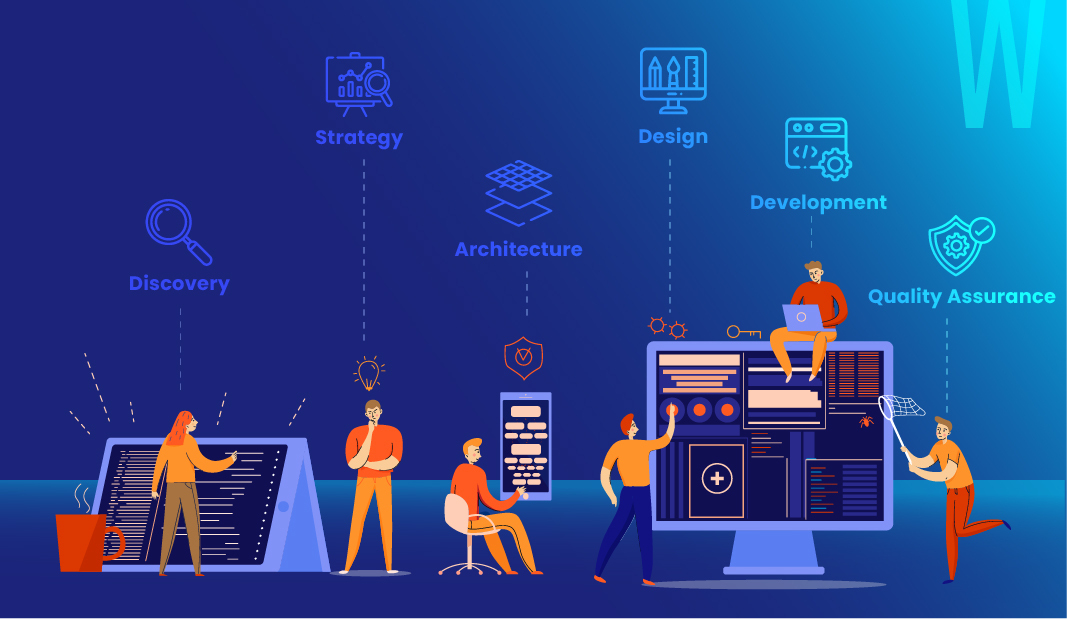TABLE OF CONTENT
Successful software development requires a solid strategy. It’s important to have a vision for your product, but it’s also crucial that you develop a plan for achieving that vision. That plan will include everything from discovering what features are needed and how best to implement them, all the way through final testing and release. This article will take you step-by-step through the process of creating a successful software development strategy:
1. Discovery
Once you’ve identified your business requirements, it’s time to start discovery. This is where you gather information and understanding of the problem. The goal of discovery is to define the project’s scope, objectives, and goals in order to ensure that they align with what your client needs in order for their product or service to be successful.
- Define the scope: In this phase, you determine what problems your client needs to solve by identifying all possible solutions as well as any dependencies between them (for example: if some feature requires another feature).
- Collect requirements from stakeholders: You will need people who represent different aspects of the company(ies) involved with this project – typically these people could include executives who approve budgets/goals; lead developers who write code; designers creating visualizations; etc.
2. Strategy
The second step in your software development strategy is to define the problem. The first thing you need to do is identify what problem you’re trying to solve, and then explain why it’s important. For example, if your company wants to become more efficient by using automation in its processes, then identifying this as a goal will help guide your project decisions. If there are multiple goals for your project (such as improving quality or increasing sales), make sure each one has its own set of KPIs and KPAs so that they can be measured independently from each other.
Once you’ve defined these two major elements of any good strategy—the problem itself and its importance—it’s time for step three: explain how they relate back together again! This means explaining how all those individual metrics fit together into something meaningful over time (which will vary depending on what kind of business model you have). You’ll also want some idea about how much effort each metric requires before it becomes useful; this could include things like cost per unit shipped rather than just raw numbers like revenue generated per month or number of new customers acquired per year.
3. Architecture
Architecture is at the foundation of your software development project strategy. It’s the blueprint for your software and its structure. The architecture defines how you organize your code, design your system, and build it all together. Though software architecture is closely related to design, architecture encompasses more than just the aesthetics or the interface. Core aspects of your software like versatility, security, adaptability, etc. depend on how well the product development team defines the software architecture.
On top of this, your product’s longevity or long-term relevance depends on how well the software architecture is designed and executed. If you look at some of the great software products in the market, they’ve all got one thing in common – a solid architecture they can rely on. At W2S Solutions, our senior software architect consultants and engineers have a proven track record of delivering dynamic software solutions to our global clients.
4. Design
Design is the process of making things work. It’s a creative process that involves working with stakeholders and customers to create an effective solution for a given problem or opportunity.
Design is also how we translate our assumptions into decisions about what we build, how we build it, and how we test it. This can be especially important when designing software products that have high risk because they require new technology or introduce new processes.
5. Development
Development is the process of creating a software application by writing codes in platforms specifically allowing developers to leverage computing power. It’s also probably the most time-consuming part of your whole software development strategy. Though different software development companies follow different methods to optimize their development time, hiring efficient software developers can be a major game-changer in saving such crucial resources without the quality depleting.
The first step in developing an application is writing code—that’s where developers come in. They write instructions for how computers should operate so that they can do what users want them to do with their applications. After that comes testing: developers test their own work against each other’s work (or other standards) before releasing anything into production. Then there are steps like ensuring all commands work correctly as well as making sure everything works on all types of platforms. Finally comes deployment: getting those newly created programs out there so that people can use them!
6. Quality Assurance
Quality Assurance (QA) is the process of testing a software product to ensure that it meets the requirements of the project. It is an important part of the software development process, as well as an integral part of other stages such as design and development.
QA can be seen as a separate stage in most projects, but it can also be integrated into other phases in order to get better results for both developer time and quality assurance resources used throughout your project.
If you want to know more about software/product development strategy and how you can build inclusive digital products to deliver unparalleled user experience, check out our detailed blog on this topic – “Let’s solve for the user: How can product development teams build more inclusive digital products?“.
Get inspired!
Subscribe to our newsletter and get updates on how to navigate through disruption and make digital work for your business!



